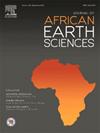Paleoredox conditions and paleoproductivity of the early-Eocene sediments in the Gaga Section, Western Desert, Egypt
IF 2.2
4区 地球科学
Q2 GEOSCIENCES, MULTIDISCIPLINARY
引用次数: 0
Abstract
The release of massive amounts of greenhouse gases, mainly carbon dioxide and methane, into the atmosphere was assumed to have generated anoxic conditions during the Paleocene-Eocene Thermal Maximum (PETM). These gases caused the globe to warm rapidly and significantly, disrupting ocean circulation patterns and reducing the quantity of oxygen accessible to marine organisms. Herein, detailed geochemical investigations were performed on forty-one cutting samples collected from the Gaga section (Egypt), with an emphasis on total organic carbon (TOC), trace elements, and carbonate content. These geochemical observations revealed important information about paleoredox conditions, marine biological productivity, and processes controlling organic matter accumulation. A sudden decrease in carbonate contents, as well as the scarcity of nannofossils, indicate the severity of the acidification during the onset of the PETM. Abundant framboidal pyrite within foraminiferal shells at the PETM interval indicates the occurrence of sulfur-related processes during diagenesis, a consequence of organic matter decomposition under oxygen-depleted conditions where sulfur-reducing bacteria play a significant role. The ratios of V/(V + Ni), V/Cr, Fe/Ti, P/Ti, Zn/Al, and Ni/Al indicate that the PETM interval was subjected to dominantly anoxic conditions under gradually increasing primary productivity. Conditions were favorable for the formation of the glauconite bed (Bed A) at the onset of the PETM, which represent unique chemical conditions, such as a warm condition, rapid transgression, a reduced sedimentation rate, intensive continental weathering, an enhanced supply of cations, and the existence of anoxic conditions.
求助全文
约1分钟内获得全文
求助全文
来源期刊

Journal of African Earth Sciences
地学-地球科学综合
CiteScore
4.70
自引率
4.30%
发文量
240
审稿时长
12 months
期刊介绍:
The Journal of African Earth Sciences sees itself as the prime geological journal for all aspects of the Earth Sciences about the African plate. Papers dealing with peripheral areas are welcome if they demonstrate a tight link with Africa.
The Journal publishes high quality, peer-reviewed scientific papers. It is devoted primarily to research papers but short communications relating to new developments of broad interest, reviews and book reviews will also be considered. Papers must have international appeal and should present work of more regional than local significance and dealing with well identified and justified scientific questions. Specialised technical papers, analytical or exploration reports must be avoided. Papers on applied geology should preferably be linked to such core disciplines and must be addressed to a more general geoscientific audience.
 求助内容:
求助内容: 应助结果提醒方式:
应助结果提醒方式:


